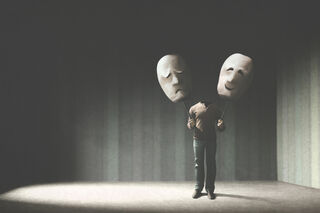Facing Off: Your Bright Side Versus the Dark Twin
How becoming your best self requires enduring the painful strain of opposites.
by Derek Lusk Ph.D.
Henry was the epitome of integrity, a man with a public image that represented everything good in the world: health, success, intelligence, and unconditional kindness. He was heralded as the town physician, conducting scientific studies for the betterment of humankind and treating people with illnesses like a superhero-resembling altruist. He was reminiscent of Mr. Rogers or the warmth of a caring grandparent, and no one questioned his genuine affection for human life.
But Henry perceived his life as bland, boring, and colorless, and he was ultimately tempted by the other side of his nature, the darker side that most of us keep hidden from sight. When the warmth of the daylight ended, Henry radically transformed into his alter-ego, Edward, who was nothing short of pure, merciless evil and unadulterated rage.
On one occasion, Edward was speedily walking down a barren part of town, on a black winter morning, and he collided with an 8-year-old girl at a cross street. He trampled over her body, leaving her crying, screaming, and wailing for her parents in the middle of the street. It was a sickening incident, described by one observer as hellish to witness: “It wasn’t like a man; it was like some damned Juggernaut.” Another said he was “hardly human” and a “murderous mixture of timidity and boldness.”
Robert Louis Stevenson’s Strange Case of Dr. Jekyll and Mr. Hyde, commonly referred to as Jekyll and Hyde, exemplifies the perennial war between the two sides of human nature:
Dr. Henry Jekyll represents the bright side. The bright side is who you are when you put your best foot forward—on a first date, sitting in church, the first few months on the job, or in an interview. The bright side controls your selfishness, allowing you to conform to the expectations of society and, even more, live up to the roles you play, such as a friend, husband, parent, teacher, executive leader, or doctor. Dr. Jekyll’s bright side persona was a good and honest doctor with altruistic values, and he played the part even when intensely selfish desires lurked behind his warm and handsome smile.
Conversely, Mr. Edward Hyde represents the darker side that exists underneath the normative expectations and façade of everyday life, often referred to as the shadow side, the disowned self, the dark twin, or the alter ego. It’s the underworld of existence that lies hidden behind conversations about the weather, behind the mindless chitchat, and your attempts to gain status and acceptance by being socially appropriate.
But the story of Dr. Jekyll and Mr. Hyde is an extreme example of the dark side. What’s more typical in the general population is subclinical, counterproductive tendencies that derail life and career success. These dysfunctional, dark side behaviors bubble to the surface under stress, pressure, frustration, uncomfortable situations, or when you are no longer required—or willing—to manage your reputation with others. And they corrupt judgment and destroy relationships, causing you to fail at parenting, friendships, leadership, and so on and so forth.
In 1950, Karen Horney published Neurosis and Human Growth, a book identifying specific toxic tendencies that plague our lives. At a high level, she organized malignant, self-destructive behaviors into three categories: distancing, domination, and deference.
Distancing is withdrawing from social situations, getting other people to go away, or creating walls that hide your inner truth. In the words of Horney, distancing “implies settling for a peace which is merely the absence of conflicts” and therefore “is a process of shrinking, of restricting, of curtailing life and growth.”
The next category, called domination, concerns having a grandiose sense of self and an unquestioned belief in your superiority and uniqueness. Horney described domination as “bent on self-glorification, on ambitious pursuits, on vindictive triumph, with the mastery of life through intelligence and will power as the means to actualize their idealized self.”
Lastly, deference is in diametric opposition to domination. While the domineering person resembles a confident, manipulative charlatan, the deferential individual subjugates themselves to forceful personality types, and even experiences discontent when they win, receive recognition, or find themselves in a position of superiority.
In summary, the reality of human existence is a double-sided, almost unbearable tension between the bright and dark sides of the human condition. To cope, you believe in your own inherent goodness, burying dark impulses and unconsciously distancing, dominating, and resigning to authority to relieve anxiety and manipulate others to meet your needs.
But using self-delusion to cope comes with a complete disregard for your deepest desires, and when they eventually become nourished, you risk overdosing and dying “to a thousand interests and aspirations, and become, at a blow and forever, despised and friendless.”
On the other hand, if you revel too much in the dark side, it grows stronger with every transgression. And when the dam begins to leak, you risk slipping so far into the darkness that distancing, aggression, greed, hedonism, or helpless appeals to authority consume every waking moment, challenging your ability to fit in with psychologically healthy friends, co-workers, or romantic partners.
Thus, the solution to the problem is living with the pain, for releasing yourself from the tension of opposites by denying the shadow, or delving too deep, almost always ends in despair. What you’re after in life isn’t the false happiness of pleasure and positive emotions or satisfying pride, power, and lust. What you really want is what everyone else unknowingly needs—meaning.
And there is meaning in the painful conflict within you. In the words of Viktor Frankl, “In some ways suffering ceases to be suffering at the moment it finds a meaning, such as the meaning of a sacrifice.” In the end, it is through meaning and the enduring pain of opposites that we locate the dark side of ourselves, shine a light on self-actualization, and integrate the shadow into a beautiful, balanced whole.